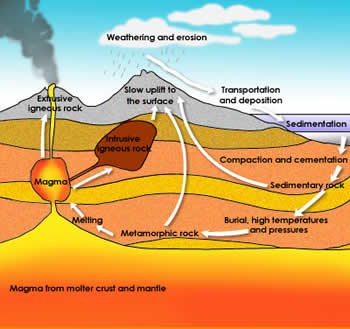Minerals form under various conditions in the earth. Most gemstones form in the Earth’s crust; the top layer of the Earth, with a depth of 3 to 25 miles. Only two gemstone varieties – diamond and peridot – form in the Earth’s mantle, which represents 80% of the Earth’s volume. The mantle consists mostly of molten rock called magma with a solid upper layer.
A few gemstones form in the mantle, but all gems are mined in the crust. The crust is made up of three kinds of rock, known in geology as the igneous, metamorphic and sedimentary rock. These technical terms refer to the way in which the rock is formed. Some gemstones are associated with one kind of rock in particular; others with several types.
The igneous process involves the solidification of magma. Magma from the mantle can rise to the crust, usually through volcanic pipes. If it reaches the surface of the earth, it solidifies as lava. However, if the magmatic mass cools slowly in the crust, it can crystallize and form minerals. Increases in pressure can also cause this pegmatitic fluid to infiltrate surrounding rocks, often making chemical exchanges with them. The long list of gemstones formed from igneous rock includes the chrysoberyl group, all quartz (including amethyst, citrine, and ametrine), Beryl (emerald, morganite, and aquamarine), garnet, moonstone, apatite, diamond, spinel, tanzanite, tourmaline, topaz and zircon.
Once the igneous rock reaches the surface of the earth, the forces of erosion and weathering produce smaller particles, which accumulate on the surface or are moved by wind and water. As time passes, layers of these sediments build upon land or underwater. The pressure from the upper layers causes compaction in the lower layers, along with various chemical and physical changes such as lithification, which lead to the creation of sedimentary rock. Evaporation is another process that produces sedimentary rock, such as the rock found in deserts. Gemstones associated with sedimentary rock include jasper, malachite, opal, and zircon.
The presence of intrusive magma in an area (known as contact metamorphism), or of tectonic plate interactions on a larger scale (known as regional metamorphism) puts igneous and sedimentary rock and minerals under heat or pressure that may cause changes in their chemistry and crystal structure. The result is the creation of metamorphic rock. Gemstones associated with metamorphic rock include beryl, jade, lapis lazuli, turquoise, spinel, ruby, sapphire, and zircon.
Rocks and minerals are in a constant state of change, which is referred to as the rock cycle. Igneous rock can change into the sedimentary or metamorphic rock. Moreover, the sedimentary rock can change into the metamorphic or igneous rock. Furthermore, metamorphic rock can change into an igneous or sedimentary rock. But you have to be patient.
Source: https://www.gemselect.com/english/other-info/gemstone-formation.php


